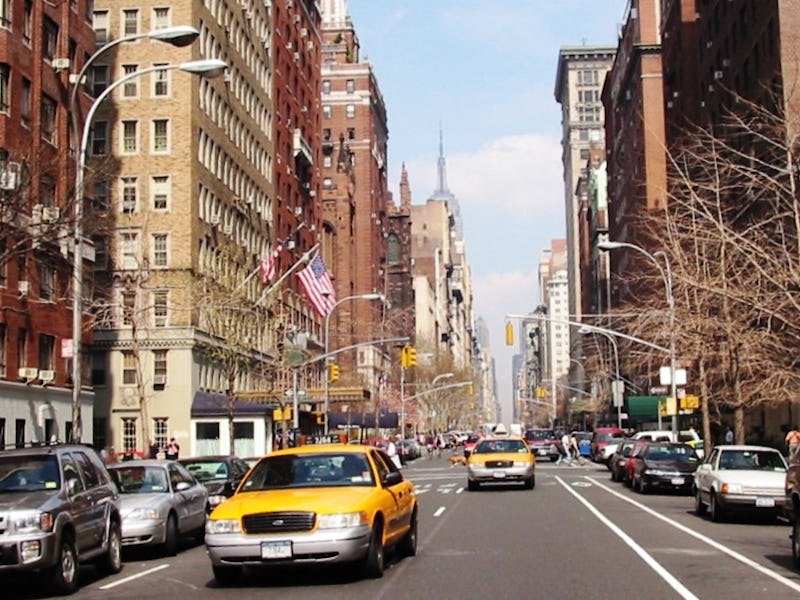Isaac Asimov's Dream of Moving Sidewalks in New York Was Beautiful and Insane
In 1964, Asimov predicted we'd be using moving sidewalks in cities by 2014. Why aren't we?

“For short-range travel, moving sidewalks (with benches on either side, standing room in the center) will be making their appearance in downtown sections. They will be raised above the traffic.” - Isaac Asimov, 1964
In 1964, Isaac Asimov wrote an essay of predictions for the World’s Fair of 2014. He made guesses about how we’d live, where we’d live, and the biggest threats to human existence. One prediction was based an already popularized notion: Moving sidewalks were inevitable. After all, the escalator-ing of the urban landscape would cut down on traffic, commute times, and pollution. It just made good sense.
Unfortunately — or maybe not, depending on how you look at it — that’s not how infrastructure works.
Asimov didn’t lay out a specific plan for this moving sidewalk, but it’s not hard to suss out the inevitable details. It would have to be covered or protected in some way. The belts would have to be relatively long and end near places foot traffic is heaviest. Systems would have to be replaced relatively frequently to deal with corrosion and other issues. Think about it for a second and you reach this conclusion: A lot of material would go into make these things, especially making them — as Asimov proposed — elevated.
The above-ground method also poses accessibility problems for those who can’t climb stairs. There would need to be elevator access, which requires further infrastructure. It’s certainly not impossible and the challenges are not insurmountable, but the traditional underground train system still seems to make more sense.
This comes down to a question of scope, too. Asimov describes downtown “sections” for these moving sidewalks for short-range travel, presumably shorter than the distance between underground train stops. It’s difficult to know exactly what he means by that (is it a mile? a kilometer? less?), and here’s where we’ve got a dilemma. These distances need to be short enough that if something were to happen to the moving sidewalk, people could feasibly go on foot to their destination without too much hassle. But, by the same token, it needs to be long enough that it makes sense to have a moving sidewalk and that it isn’t more hassle than it’s worth. It’s about finding a point of diminishing returns and balancing that point with maintenance issues — the longer a length of moving sidewalk gets, the more susceptible it is to damage and breakdowns somewhere along the line.
Now, it’s important to note that moving sidewalks have been done. They’ve just been small scale. We see them in airports and they’ve been implemented in sections of Paris and Australia. So in a way, Asimov was right. But they’re not exactly common, and it has nothing to do with our ability to implement a system like this and everything to do with justification. Is there really a large enough need that trains and buses don’t fill to justify building a moving sidewalk? Are there funds for that? Can the city afford to maintain it?
To be sure, moving sidewalks would, under the right circumstances, be markedly easier than buses and trains. One would be able to step onto a constantly moving platform without delays (unless it’s broken down) and save several minutes in walking a short distance every day. But the cost is significant, and the infrastructure problems are many.
All told, in large cities where people are moving from one portion of the city to another with relative frequency, trains make more sense. They’re faster, the tracks are durable, cars are replaceable and can be swapped out for repairs, they already have a system for letting people on and off for (relatively) short-range travel, and have the luxury of working just fine above and below ground.
It’s not that moving walkways and sidewalks aren’t possible in city settings, it’s that they’re not smart. Could we use more trains in more cities or even more stops in cities that already have trains? Absolutely. And ultimately, that makes more sense. Tying into a larger system instead of creating “sections” is more beneficial to all who use the system. It’s not that moving sidewalks are impossible or infeasible, they’re just impractical, and that’s the problem.
Maybe if our cities were designed differently, we could find a way to build a system of sections of moving sidewalks. Maybe if we were pedestrian-minded and more motivated to cut down on vehicles as a primary mode of transportation, we’d find the money and the resources and the solutions to make moving sidewalks a part of our public transportation systems. Maybe in an alternate future.